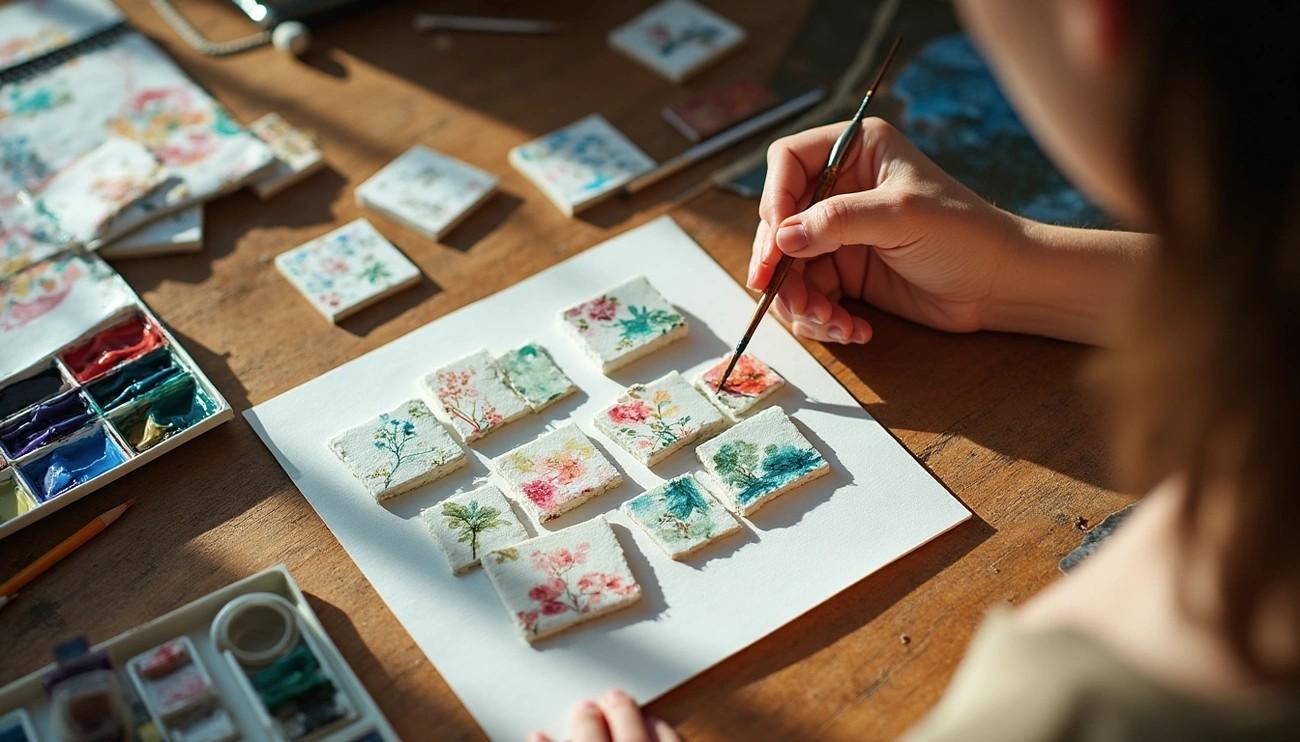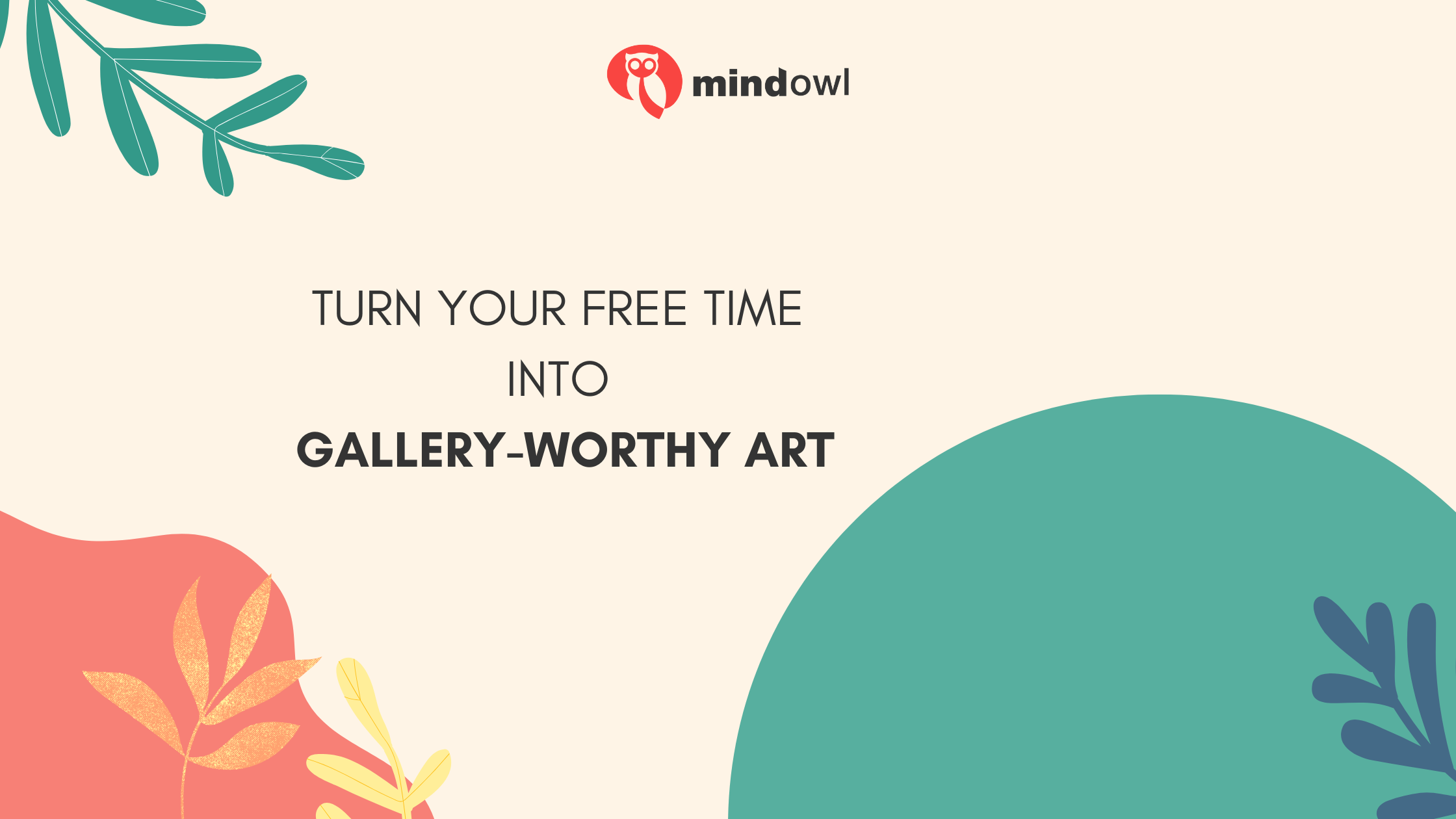
People often neglect their creative hobbies because of daily scrolling habits. Statistics show we spend 2-3 hours or more on our smartphones daily. This valuable time could help us create meaningful art instead.
The Inchie Challenge presents a way to achieve something more meaningful. Anyone can create a tiny 2 x 2 inch art piece daily for 12 days. This simple approach makes art available to people with packed schedules and turns brief moments into opportunities that spark creativity.
This piece reveals practical methods to blend art-making with your daily routine. You’ll learn to build portable art kits and develop your skills through consistent practice. These small artistic efforts add up quickly and can produce impressive results when combined together.
Start Small to Build Confidence
“Great things are done by a series of small things brought together.” — Vincent Van Gogh
A blank canvas can stop many potential artists in their tracks. Starting small breaks this barrier and makes art available, practical, and less daunting for beginners.
Why tiny art works for busy people
Tiny art fits perfectly into hectic schedules. Small pieces need minimal setup and cleanup time, so you can squeeze creativity into your packed days. You don’t need to wait for those mythical large chunks of free time – just 10-15 minutes will do.
Small formats solve practical problems too. They need fewer supplies, which helps if you’re on a tight budget. It also works great without a dedicated studio – a kitchen table or lap desk is all you need. This makes the “I have no place to create” excuse disappear.
Small art feels easier to handle psychologically. Your brain feels less pressure when you face a tiny canvas instead of a large surface, and creativity flows naturally.
How 2×2 inch pieces can realize creativity’s potential
The 2×2 inch format pushes you to solve problems creatively. Limited space makes you choose what’s essential and find ways to express yourself clearly. These constraints often lead to state-of-the-art ways to create.
Quick wins from small art build momentum. Finishing a piece in one sitting gives your brain that satisfying dopamine boost. You’ll want to keep coming back to create, and your skills will grow through practice.
Mini projects are low-risk by nature. The fear of “ruining” your work fades since you’ve invested little time and materials. This freedom lets you try new techniques, colors, and styles you might avoid in larger, “serious” pieces.
Examples of small formats that work
These tiny formats have proven especially effective for busy creators:
- 2×2 inch mini canvases: Perfect for acrylic painting beginners, these tiny surfaces work great for simple subjects like cherries, landscapes, or abstract designs
- Index cards: Their standard size and availability make them ideal for daily art practice
- Inchies: These 1×1 inch squares work well with collage elements, doodles, or ink experiments
- Business card backs: Old business cards become mini canvases for daily creativity challenges
- Portable watercolor papers: Pre-cut small watercolor papers let you sketch nature anywhere
Starting small helps build your confidence through regular practice while developing your unique artistic voice. The skills you learn will carry over to larger pieces as your confidence grows.
Make Art Portable and Accessible
Your art supplies can turn ordinary moments into creative opportunities. They should become part of your daily gear, just like your favorite book or smartphone.
Create a DIY art kit for your bag
A good portable art kit needs to balance portability with functionality. A small container will do the trick—many artists like using a cosmetic bag, stool bag with storage, or even a repurposed DVD case. Here’s what to pack:
- Essential supplies: A small sketchbook (5×3″ or A6 size works well), mechanical pencils to skip carrying sharpeners, and a few quality pens
- Color options: Mini watercolor sets, travel-sized pastels, or scribble sticks you can use dry or with water
- Practical additions: A portable water brush, mini spray bottle, and a folding water cup for water-soluble media
If you’re looking for an easy and relaxing way to create while on the go, you might also consider including a popular paint by numbers kit. They’re compact, mess-free, and perfect for unwinding creatively wherever you are.
Use waiting time to sketch or doodle
Life gives us plenty of “dead time”—minutes spent at appointments, during commutes, or at children’s activities. These moments are perfect for creative hobbies.
You can sketch during airport layovers. Quick thumbnail silhouettes work great for capturing people in motion. Doctor’s offices, music lessons, or coffee shop queues become unexpected creative sessions.
Start by getting comfortable with sketching in public. Most people are too busy to notice you drawing. Quick sketches should become your go-to—sometimes you’ll have just 30 seconds to capture a gesture.
Keep supplies in multiple places
Your creativity becomes inevitable when you place art supplies throughout your space. Mini sketchbooks and pencils should live in your car, office desk, bedside table, and kitchen drawer.
A rolling cart works exceptionally well—fill it with DIY art supplies and move it wherever inspiration hits. Artists who enjoy painting outdoors love tiered rolling carts that let them move their studio between rooms or outside.
Bar carts make great art storage on wheels. Put your frequently used items on top and keep replacements on lower shelves. This setup will give you quick access to creative tools, no matter where you prefer to work.
Turn Repetition Into Mastery
“If people only knew how hard I work to gain my mastery. It wouldn’t seem so wonderful at all.” — Michelangelo
Repetition serves as the foundation of artistic growth. Artists who practice regularly build stronger neural pathways than those who practice sporadically. These pathways turn uncertain marks into confident creative expressions. This basic element of studio art creates visual rhythm and helps develop your artistic voice.
Repeat patterns to boost skills
Your brain strengthens its connections every time you practice a technique. This neuroplasticity turns calculated movements into muscle memory. You can then focus on creative expression instead of technical details.
Daily pattern practice trains your brain and muscles to work as one. The process might feel mechanical at first, but your actions become more natural as you continue. This steady practice shows your natural approach to creative work – it’s like your artistic fingerprint.
Learn variations on a single theme
Repeated work with the same subject leads to deeper insights. Look at how Matisse painted several piano-themed pieces between 1924-1925. Each painting showed the concept from a different view. You can apply this same method to your work.
This method lets you see beyond surface details. Each new piece reveals subtle elements you missed before. Working on one subject from different angles sharpens both your observation skills and technical abilities.
Use repetition to build a cohesive series
A unified collection starts with clear boundaries. Pick your theme, format, and colors before you begin. These limits actually boost creativity by reducing overwhelming choices.
Working on multiple pieces at once works best. Keep several DIY art pieces going together to see how they complement each other. This approach will give your work unity while each piece keeps its unique character.
Repetition does more than just improve your skills – it connects your separate works. Recurring elements create rhythm and harmony. These connections turn individual pieces into gallery-ready collections that leave a lasting impression.
Combine Small Works Into Big Impact
Small art pieces hide a special power—they become something much greater when combined thoughtfully. Your creative hobbies can make an impressive visual statement while staying manageable.
Create a gallery wall from mini pieces
Gallery walls turn tiny artwork collections into unified visual statements. These arrangements create what neuroscientists call “organized complexity”—a structure that feels intentional yet keeps viewers interested.
Your largest piece should sit in one of the four outer corners for smaller collections, or slightly off-center for larger groupings. This placement guides the viewer’s eyes around the composition instead of fixing on one central point.
A good gallery wall needs smart spacing—keep about 3 inches between pieces to avoid crowding. You can also create “mini collections” within your larger arrangement by putting 2-4 related pieces together. This creates a gallery-within-a-gallery effect.
Make pop-up books or layered journals
Pop-up features add unexpected depth to small artwork collections. A simple pop-up element comes to life when you fold paper in half, make two parallel cuts on the fold, and push the center section outward. This technique turns flat illustrations into 3D experiences that engage viewers.
Mini-books showcase themed collections of small artwork perfectly when you combine multiple pop-up pages. Your delicate creations stay protected between covers.
Turn your DIY art into greeting cards or gifts
Small artwork makes wonderful greeting cards that people often keep longer than store-bought ones. Digital artwork should maintain at least 300 dpi resolution for professional results.
Your handmade cards stand out when you include details from your original artwork on both front and inside, along with title and contact information. Photo insert cards with window frames display 4×6 inch artwork without damaging the original piece.
Use themes to tie pieces together
Themes turn random art pieces into compelling visual stories. You might tell geographic stories through artwork from meaningful places, create artistic dialogs between different artists exploring similar subjects, or trace a color’s journey from light to dark.
The best approach balances structure with variety—experts call this “theme and variation”. A clear primary theme sets the stage while secondary elements add depth without chaos.
Your smallest creative efforts build up to gallery-worthy impact when combined thoughtfully, fitting easily into busy schedules.
Conclusion
You don’t need extra time or a perfect setup to create meaningful art. Small projects like the Inchie Challenge turn spare moments into creative progress, helping you build skill, confidence, and a body of work that reflects your unique voice.
Start small, stay consistent, and let those tiny pieces add up to something powerful. In the process, you’ll discover that creativity fits into your life more easily than you ever imagined.
MindOwl Founder – My own struggles in life have led me to this path of understanding the human condition. I graduated with a bachelor’s degree in philosophy before completing a master’s degree in psychology at Regent’s University London. I then completed a postgraduate diploma in philosophical counselling before being trained in ACT (Acceptance and commitment therapy).
I’ve spent the last eight years studying the encounter of meditative practices with modern psychology.

